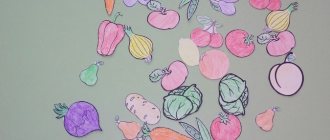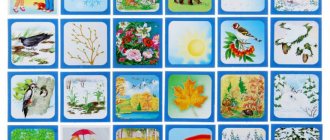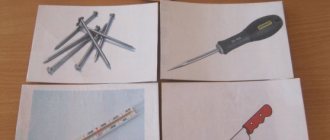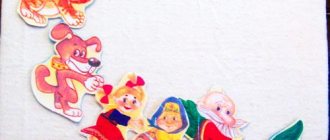It's a sad time! Ouch charm! Your farewell beauty is pleasant to me - I love the lush decay of nature, Forests dressed in crimson and gold... (And S Pushkin)
Many poets loved and sang autumn in their works. Indeed, it’s impossible not to admire autumn. It seems that nature, before falling asleep and covering the earth with a white, fluffy blanket, decided to arrange a fair of bright colors and delight us with an abundance of different shades. We adults must teach the child to see this beauty and admire it. Finger games about this wonderful time of year will help us get acquainted with changes in nature.
"Autumn".
The north wind blew: “S-s-s-s” (blowing)
I blew all the leaves off the branches... (move your fingers and blow on them)
They flew, spun and sank to the ground (wave their arms in the air)
The rain began to patter on them
Drip-drip-drip, drip-drip-drip! (tap the fingers of your right hand on the palm of your left hand)
The hail pounded on them, (with a pinch of your right hand, tap on your left palm)
It pierced all the leaves. (knock the fist of your right hand on your left palm)
The snow then powdered (smooth movements of the hands back and forth)
He covered them with a blanket. (place your right palm on your left)
Card index of didactic games for children 3-4 years old “Autumn Leaves”
DIDACTICAL GAMES “AUTUMN LEAVES”.
GAMES FOR CHILDREN 3–4 YEARS OLD.
Didactic tasks:
Learn to assemble a whole from parts; consolidate knowledge about color, size; develop visual perception, thinking, attention, logic; develop fine motor skills of the hands; develop speech.
Material
: from colored cardboard (green, yellow, red, orange), cut out maple leaves, size (large - small, in pairs. Cut each leaf in half, leave one pair uncut for the sample.
Option 1. “Collect leaves”
Goal: to develop children's constructive skills, visual attention; develop thinking, attention, creative imagination.
Progress of the game:
The adult invites the child to assemble the leaves from the parts, noting that the leaves are of different colors and sizes.
“A strong wind blew and the leaves flew away. Let's collect them."
Together with your child, fold the halves of the leaves to make whole ones.
Option 2. “Who has this piece of paper? »
Purpose: to distinguish children's constructive skills, visual attention; consolidate knowledge of colors (red, yellow, green, orange, sizes (large, small); develop speech, enrich vocabulary.
Progress of the game:
The adult gives the children one half of the cut pictures each, and keeps the remaining parts for themselves. He asks who should be given each of the halves in order to put together the whole pictures. When children choose their halves of autumn leaves, taking into account color and size, each child adds up the whole image and tells what kind of leaf he got (big red, small green, etc.)
The following options for playing with collected leaves.
Option 3. “Pick up the leaves”
Material: the same as in the previous game. Trees cut out of cardboard in yellow, red, orange, and green are added.
Goal: to teach children to distinguish colors (yellow, red, orange, green); teach to match leaves by color.
Progress of the game: Invite the child to place the leaves on the trees of the corresponding color so that the leaves are the same color as the tree.
Option 4. “Big and small leaves”
Goal: to teach children to distinguish leaves by size, to consolidate the concepts: big - small.
Progress of the game:
The adult places two pieces of paper (samples) on the table and invites the child to put large pieces of paper near the large piece of paper, and small pieces of paper near the small piece of paper.
Option 5. “Show me a piece of paper”
Goal: to teach children to show leaves according to the word denoting color. Strengthen children's ability to distinguish and name colors (green, yellow, red, orange).
Progress of the game:
The adult invites the child to show yellow leaves, red, green, orange.
Option 6. “Show me a piece of paper”
Goal: to teach children to show leaves by word indicating color and size. Strengthen children's ability to distinguish and name colors; consolidate the concepts of “big” and “small”.
Progress of the game:
The adult asks the child to find a piece of paper with a certain color and size.
- “Show me the big red leaf.”
- “Show me the little green leaf,” etc.
Option 7. “Name the leaf”
Goal: to teach children to name the color and size of a leaf. Strengthen children’s ability to distinguish and name colors (green, yellow, red, orange) and sizes (big and small, develop speech.
Progress of the game:
The adult points to the piece of paper, and the child names what color and size.
Option 8. “Find a pair.”
Goal: the ability to select pairs based on similar sensory attributes of color or size; develop visual perception.
Progress of the game:
An adult invites the children to look at the leaves and asks them to name the color. Then he invites the children to pick up pairs of colored leaves. Complication: take from 4 to 8 leaves.
Option 9. “Find the extra leaf
»
Goal: to develop children's visual attention and thinking, logic.
Progress of the game:
The adult invites the child to choose an extra leaf. In front of the child, leaves are laid out, united by some characteristic, for example, by size or color; one of them does not have such a characteristic and is superfluous.
Option 10. “What has changed? »
Goal: development of visual perception, memory, speech, enrichment of vocabulary.
Progress of the game:
An adult lays out several pieces of paper on the table.
The child is asked to close his eyes. An adult removes or swaps the leaves.
- "What changed? "
Invite your child to talk about the changes.
Option 11. Outdoor game “1, 2, 3, collect a piece of paper!” »
Goal: to develop children's constructive skills, visual attention; develop thinking, consolidate knowledge about color and size, develop auditory and visual perception.
Progress of the game:
An adult gives children one half of the cut pictures. Children walk around the playground. At a signal, they scatter and run in any direction. At the signal “collect 1, 2, 3 leaves” they stand in pairs. (Music accompaniment is used).
Complication: change the pair each time.
"Autumn"
The sun is already barely warm; (we spread our fingers on both hands and connect
palms together, then join fingers)
Migratory birds have flown south; (we wave our arms like wings)
The trees are bare, the fields are deserted, (we raise our hands)
The first snow covered the ground. (smoothly lower the handles down)
The river is covered with ice in November - (we squeeze our hands into a lock)
It's late autumn in the yard. (we spread our hands in front of us)
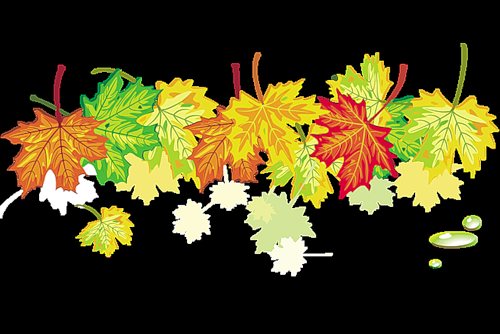
There are also fun things for kids, who can always be occupied on a long trip, or in rainy weather at home or in the country. All you need is a pencil and a piece of paper...
Games for the little ones
Among the rather complex “paper” games, games stand out that are quite within the capabilities of children.
Snake
This is not only an educational game - it strengthens naughty fingers that are just learning to draw straight lines.
Take a piece of squared paper. Limit the square playing field to 7x7 cells. Two adjacent sides of the square should be one color (for example, red), the rest - another (for example, blue). Place red and blue dots in random places on the playing field. Now the players must take turns making moves, starting to draw broken snake lines from the point of “their” color with “their” pencil. In one move, extend the line by one cell in any direction (but not diagonally). The lines cannot intersect; they can be drawn along the side of the playing field, but these should not be the sides of “their” color. The one who has nowhere else to extend his snake loses.
Eight-flowered flower
First, draw a flower with eight identical petals, then choose several pencils of different colors - and you can start coloring the petals. They do this one by one, adhering to a certain rule: during your turn you can paint any one petal or two adjacent ones. The one who colors the last petal wins.
It is advisable to give in to the child every once in a while, gradually leading him to the idea that winning in this game is not an accident, but the result of carefully thinking through the moves. It is not difficult to reduce the game to a situation where the child’s win or loss will depend on one correct or incorrect move. Draw your child’s attention to this by noting: “If you color the petals correctly now, I won’t be able to beat you, if not, I’ll win.”
After several attempts and thinking, the baby will learn the correct tactics of the game. This will bring him both pleasure from his own achievement and the understanding that many problems can be solved independently for his own benefit.
“Cheers, I’m putting crosses!”
Even three-year-old children enjoy playing tic-tac-toe, and for them it is not just fun, but a real educational mathematical game. After losing several times, they quickly realize that they don’t have to fill in the cells haphazardly. In order to win (or rather, bring the game to a draw), you should develop certain game tactics and think one step ahead.
Paths
Draw two houses on both sides of the sheet and a path between them. Near the houses you can draw or paste an image of any animal or other character cut out from a children's magazine. Tell your child that the animals come to visit each other and you need to help them: he must draw a felt-tip pen along the path.
You can draw not two, but three or four houses and several paths between them. The paths in different drawings can be different - straight or winding, narrow or wide.
You can connect beads to one another, carriages on a train to each other, camels in a caravan, etc. You can finish drawing broken steps near a ladder, stems to flowers, or the rain that pours from a cloud so that these flowers grow.
Catch-up
A variant of the previous game, when one character catches up with the other. Draw a path going in a circle with two or three characters on it. You need to draw in a circle.
Connector waves
Draw stripes of different lengths. The plot of the game can be invented in accordance with the interests of the baby. These could be little animals - their balloons have flown away; they must be connected by “tying” them with strings. You should also draw the strings, but dimly, for example in light gray, so that the baby can see where to draw the line.
Draw a lake or river with ducks or ships swimming along it. Draw waves on the water - small S-shaped lines. During the game, the baby will need to trace them and/or draw new waves.
Games for preschoolers
Ordinary tic-tac-toe quickly gets boring even for little ones. And when this game is mastered, it makes sense to move on to a more complicated version - three-dimensional. Draw a cube, draw each of the three visible faces into nine cells - you get three playing fields at the same time. Otherwise, the rules are the same: three X's or O's in a row on any side mean victory.
True, now the baby will have to keep track of a much larger number of combinations, and also use his spatial imagination. And when the child can easily navigate the three-dimensional game, you can try playing with him a paper version of the Japanese game Renju, which means “string of pearls.”
The goal of the game is to place five zeros or crosses in a row. The game is played on a playing field measuring 15x15 or 19 x 19 cells - this is a more serious task! And if after some time an adult has to really rack his brains to win against his own child, he can safely be proud of his student!
Sea battle
The rules of this popular game are known to almost everyone. But there are several tactical tricks, and if you share them with your child, the likelihood of his victories in paper-sea battles will increase significantly. The most rational move is to fire two consecutive shots in the shape of the letter L, similar to the move of a chess knight. This will make it possible to quickly identify long enemy ships.
As you know, in this game even one meaningless move gives the enemy a significant advantage, and therefore it is very important not to make ill-considered shots. Advise your child to mark each enemy ship shot at with dots: firstly, the child will not accidentally shoot at a useless place, and secondly, with this tactic, the possible locations of the ships are clearly visible.
Corridors
Many games on paper involve fighting over territory. In addition to being exciting, such games also develop logical thinking and attention.
Draw the playing field on a piece of checkered paper. Its shape and size are not of fundamental importance: it can be a square or any shape. And to interest the baby, draw a Christmas tree, a dog or any other outline. The younger the child, the smaller the playing field should be. It is better to take paper with large cells.
Armed with pens or markers, start playing. Each player takes turns drawing horizontal or vertical lines onto one cell. The one who managed to draw the last, fourth line closing the square puts his sign (cross, zero or any other) inside the square cell. When all the cells of the playing field are filled with icons, count their number and determine the winner.
Dots
This is a simplified paper version of the famous Japanese game Go. It develops tactical and strategic thinking and is one of the most favorite school and student games during lessons and lectures.
The playing field is an ordinary sheet of checkered paper, and if you have time and patience, you can play on an entire notebook spread. To ensure that fewer conflicts and controversial situations arise during the game, circle the playing field with a line and prohibit placing dots outside this border.
Each player should have a pen or pencil of their own color. Place dots one by one in random places at the intersection of cells. The goal of the game is to capture as many paper possessions as possible. A territory is considered captured if it is surrounded by dots of its own color. The points should be located one cell apart from each other horizontally, vertically or diagonally. Paint over the captured territory with your own color or draw a fortress wall (thick line) around it.
If you manage to encircle the enemy’s territory or points with dots, it is considered captured. After such a capture, the player is given the right to an extraordinary move. In some variants of the game, you can only capture those territories where there are already enemy fortifications. In others, any land, including vacant land, is available.
At the end of the game, calculate the area of captured land and declare the winner. Often there is no need to count anything: the result is obvious. You can try to play this game not only with schoolchildren, but also with toddlers. In this case, make the playing field very small - a quarter of a notebook page or even less.
Drawing fantasies
This game will require a little preparation, but then it will be enough to just pull out the treasured box from the closet, and the baby will instantly turn from bored into a gambler, artist and dreamer.
First make the playing field. A thick landscape sheet or a sheet of cardboard is quite suitable for it. Mark the start and finish on the playing field, and between them draw a winding path of 32 circles with numbers. Now prepare small cards according to the number of circles (for example, a pack of paper or cardboard for notes). On each card, put a number and write mysterious phrases like “draw huge red eyes,” “draw donkey ears,” or “add rooster paws.”
When you finish the preparatory stage, proceed directly to the game. Use chips and a cube from any board game or use buttons or toys from Kinder Surprises as chips. While playing together with your baby, you need to create a biting byaka. First, draw the base - a torso with a head of any kind, and fill in small details like eyes, nose, mouth, arms, legs, ears, horns, etc. during the game, relying on cue cards.
So, place your chips at the start and throw the dice one by one. Find a card with the same number to which the chip moved, read the task and finish drawing frog legs, horse hooves, a crow's beak or dragon thorns for your monster - in accordance with the instructions on the card.
There can be two game options. All players must either create one common mysterious creature with many paws, eyes and tails, or each draw their own. When all the chips reach the finish line, compare the drawings and find out whose monster turned out to be the funniest, scariest or most “correct”. However, it’s not so much about the winner, but about the process of play and creativity itself. It is better to come up with tasks for cards together with your child, and if he is just now learning to read, write the inscriptions in large, clear letters. Then you will get not only an entertaining game, but also a reading simulator. Which young dreamer would refuse the opportunity to add fish scales, a dragon tail, or three glowing eyes to a monster?!
There is another, simpler version of this game. It is advisable that at least three people participate in it, but you can play together with your baby. The first player draws a head (this can be the head of a person, an animal, or a creature of unknown origin) and a neck, then he must bend a piece of paper so that the head is not visible, but only the neck remains.
The next player must complete the torso, which can also be anything (with paws, arms, tail, etc.), and again fold the sheet of paper so that the next participant in this fascinating process will finish the job started by completing the creature’s legs (paws, flippers, fish tail, etc.). Since the players do not know whose body parts each of them represents, it can turn out to be a very funny miracle Yudo that will amuse everyone with its unusual appearance.
Word game
Write 20 words on a piece of paper in advance - common nouns in the nominative singular. Prepare two or three of these twenty: experience shows that they will like this game and will want to repeat it, especially since the first round will be like a test.
When it’s time to play, give everyone a blank sheet of paper and a pencil and say something like this: “Draw the sheet into twenty squares. I have a list of twenty words. I'll say the first word and count to three. During this time, you must make a drawing in the first cell that symbolizes the concept contained in this word.”
The game is that using your drawings you will then have to, when all 20 cells are filled, reproduce the very words that these drawings mean. Naturally, a quick reaction is needed here: in three seconds, find and capture some characteristic feature. So, if the word hare is named, it is enough to draw two long
ear; a few stripes will indicate that a tiger has been named. When all the cells are filled with drawings, write captions for them. Whoever can reproduce the most words is the winner.
As players master the game, offer them words that are more difficult to depict graphically, for example: laziness, health, braggart.
The most interesting thing here is to look at the drawings of other players.
Chain of words
Say a word. At the same time, start writing a word chain in which each subsequent word should begin with the last letter of the previous one. For example: table - spoon - watermelon - tooth, etc.
The one who writes the most words in 3 minutes wins. The game can be complicated by writing, say, the names of cities.
Palms
Target:
develop attention and fine motor skills, learn to quickly navigate numbers.
This game will be interesting for children who are already familiar with numbers.
Take two sheets of paper in a box and circle your baby’s hand or yours on each. In order to even out the chances a little, circle your hand on your sheet, and his on the baby’s sheet to reduce the playing field. Now, in the space limited by the drawing, randomly place dots with numbers from 1 to... What the numbers will be depends on the age and knowledge of the baby. For the smallest ones, up to 10 is enough, and for “advanced” mathematicians, up to 100 is enough.
After this the fun begins. The first player must name any number and, while the opponent is looking for it on his playing field, quickly put crosses in his cells. You need to have time to cross out as many of them as possible. Then the turn goes to the opponent. The winner is the one who fills all the cells of his field with crosses faster.
8-9 cells wide. It can contract and expand at will. Naturally, the younger the rider, the simpler the trajectory should be.
Mark the start and finish on the course. You need to play in turns: everyone “rides” a line of their own color, drawing segments along the cells horizontally, vertically or diagonally. You can move at speeds from 1 to 6. The first speed is a line 1 cell wide, the sixth, respectively, 6. You can increase and decrease speed gradually, increasing or decreasing the segments of movement by 1 cell. The goal of the game is to be the first to reach the finish line, choosing the optimal trajectory and speed.
Route
I must say that paper is an excellent material on which you can organize real races. This game, which develops logic and motor skills and helps reinforce the basics of addition and subtraction, can be played even with a 4-5 year old child.
Take a piece of squared paper and draw a race track on it - a winding path
This game is old, but it, nevertheless, has not yet lost its popularity.
On a sheet of paper, draw out a playing field with large 5x5 cells (for experienced players, the field can be 6x6 or even 7 x 7). In the middle row, write a word of five letters (in complicated versions - of six and seven letters, respectively). Now the players must take turns making moves. In one move, you need to write a letter in an empty cell in such a way that a new word is formed. Words can be read in any direction,
except diagonal. For each new word, the player scores as many points as there are letters in his word. The game ends when all the cells are filled or when none of the players can come up with a word. Now count the number of points. Whoever has more wins.
Cipher letter
Children simply love all kinds of encryption and mysterious notes. Come up with a clue code with them, depicting each letter of the alphabet with a certain icon (just a triangle, a triangle with a dot inside, an asterisk, a square, a bracket, a diamond, etc.). Now, using these figures, compose secret messages for your child, first of just a few words, and then longer ones. For a young detective, deciphering a text will not be easy, but a very useful and exciting task that will require a high degree of attention, composure and perseverance.
Bulls and cows
The classic version of the game is guessing a combination of four numbers from 1 to 9 (all four numbers must be different): one of the players writes the intended combination on a piece of paper, and the second tries to guess it. The guesser writes down on his piece of paper and names any combination. The opponent compares it with his own and gives tips. Each correctly guessed number is called a “cow,” and if the number is not only guessed but also in the correct place, it is called a “bull.”
Let's say the guessing player correctly named two out of four numbers and guessed the location of one of them. The clue should be: “Two cows and one bull.” Based on the information received and reasoning logically, the player makes the next assumption - and so on until the entire combination is solved. Then the players change roles.
This version of the game is suitable for younger schoolchildren, but for 4-6 year olds the game should be simplified a little. Firstly, replace the numbers with colors, and secondly, reduce their possible number to six. Now one player must guess the colors by placing four different-colored sticks out of six possible in a row, and the second player must solve them. Otherwise, the rules are the same. You can play openly with your baby several times, making sure that he clearly understands the rules of the game. In a simplified version, with the right train of thought, the combination is solved in 3-5 moves.
Nonsense
This seemingly goofy game can be incredibly fun when played with the whole family.
Take each person a piece of paper, on which at the top write the answer to the question “Who?” (Winnie the Pooh, cat Behemoth, neighbor Uncle Vasya, etc.). Then fold the answer so that it cannot be read, and pass the sheets around. Next question: “With whom?” Then, in turn: “When?”, “Where?”, “What did you do?”, “What came of it?” When you have written all the answers, unfold and read the papers.
"So what's the point of all this?" - a serious adult will ask. The meaning, of course, is not enough, but if the whole family laughs at the resulting nonsense, if parents and children are interested and having fun together, isn’t this the main point of a family game?
"Mistress"
The hostess came from the market one day, (we walk our fingers on the table)
The hostess brought it home from the market: (clap our hands)
Potatoes, cabbage, carrots, peas (we fold them one by one)
fingers on the left hand)
Parsley and beets, oh! (clap our hands)
Covered with a lid, in a stuffy pot (we collect the right palm with a “bucket”, cover the left one on top like a lid)
They were boiling, boiling in boiling water: (we twist our hands in front of us)
Potatoes, cabbage, carrots, peas (we bend our fingers one by one)
Parsley and beets, oh! (clap our hands)
And the vegetable soup turned out to be quite good! (show thumb)
"Hedgehog"
One hand (palm open, fingers spread) is a hedgehog, the fingers of the other hand are forest animals.
We squeeze each finger of the other hand with one hand.
“A hedgehog walks through the forest, handing out nuts to everyone. (spread the fingers of the right hand - this is a hedgehog, the left hand is clenched into a fist)
Little white bunny (bend the little finger),
Gray top (bend the ring finger)
Red fox (bend the middle finger),
To the sister squirrel (bend the index finger),
And the hedgehog gives pine cones to the teddy bear (bend the thumb).
Outdoor games at the autumn festival in kindergarten. Junior group
Outdoor games for autumn entertainment for younger preschoolers 3-4 years old in kindergarten
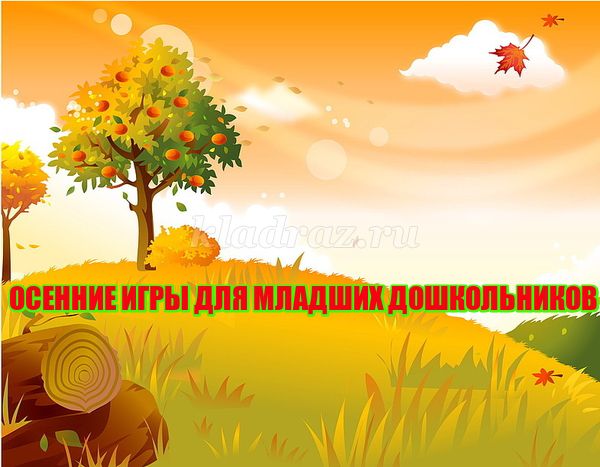
Author: Svetlana Nikolaevna Kryuchkova, music director of MDOU Kindergarten No. 127 “Northern Fairy Tale”, Petrozavodsk Description of the material: the material is designed for children 3-4 years old (junior group), can be useful for music directors and educators. Games can be included in autumn entertainment or any activity with children as a fragment. Goal: creating a joyful mood in children Objectives: - to bring joy to children - to consolidate preschoolers’ ideas about the signs of autumn - to develop the creative abilities of preschoolers
GAME “MAGIC UMBRELLA”
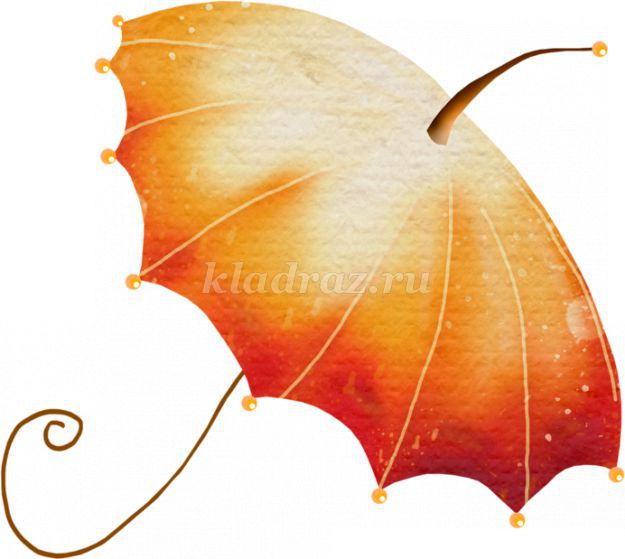
1. I spin the magic umbrella, - the presenter spins the umbrella.
I turn all the kids.
You guys will spin around - the children will spin around themselves
And turn into LEAVES.
A light breeze is blowing, a leaf is flying with the breeze. - the children easily run on their toes around the hall 2. I spin the magic umbrella, - the presenter spins the umbrella,
I transform all the children.
You guys will spin around - the children will spin around themselves
And turn into HARNIES.
In the autumn meadow, mischievous bunnies are jumping. - children jump in the form of bunnies on two legs 3. I spin the magic umbrella, - the presenter spins the umbrella
I transform all the children.
You guys will spin around - the children will spin around themselves
And turn into TEARS.
The bears sing a song and waddle. - children walk in the form of bears, waddling from foot to foot 4. I spin the magic umbrella, - the presenter spins the umbrella
I transform all the children.
You guys will spin around - the children will spin around themselves.
Turn into little birds.
Birds are pecking grains, Birds are singing songs. - the children, squatting down, “peck the grains” 5. I close the magic umbrella, - the presenter spins the umbrella,
I turn everyone into children.
Spin, turn around - the children are spinning around themselves
And turn into children.
GAME “RAIN AND SUNSHINE”
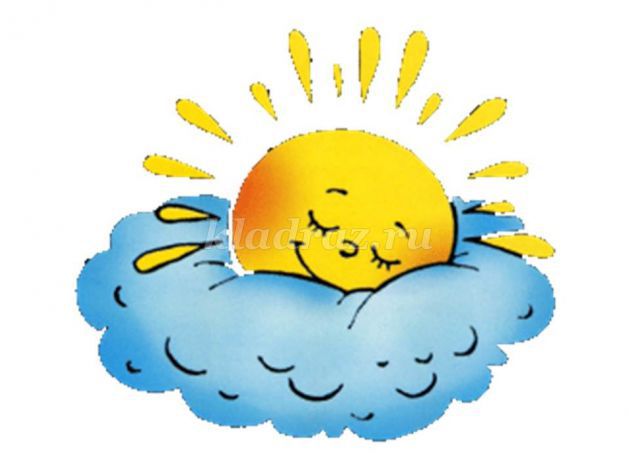
(a phonogram of rain sounds sounds, the presenter opens an umbrella)
You guys, don’t yawn, gather under my umbrella.
- the children stand under the umbrella of the leader.
Together we’ll wait out the rain, and then we’ll go for a walk.
The rain stopped falling, He was probably tired. Let him rest a little, Well, let's go for a walk! We walk along the paths together - the children walk scattered around the hall.
We raise our legs higher.
The sun shines on us from heaven, illuminating the forest with light. To the sound of rain, children again hide under an umbrella
GAME “PUDDLES”
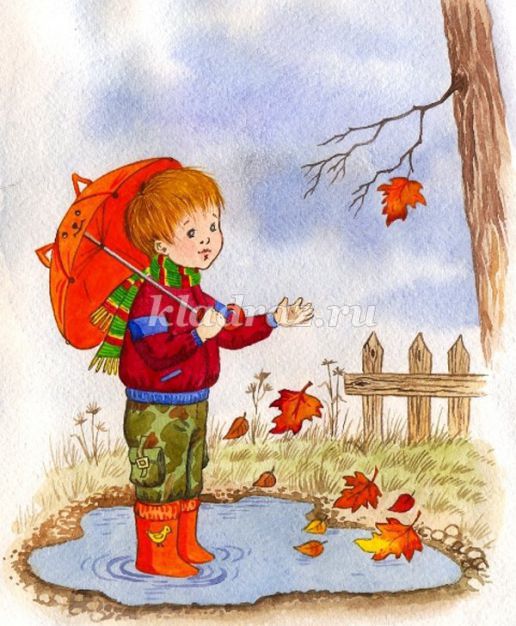
Now we’ll go for a walk, and we’ll cross all the puddles. Models of puddles are laid out on the floor, children follow each other, stepping over the puddles.
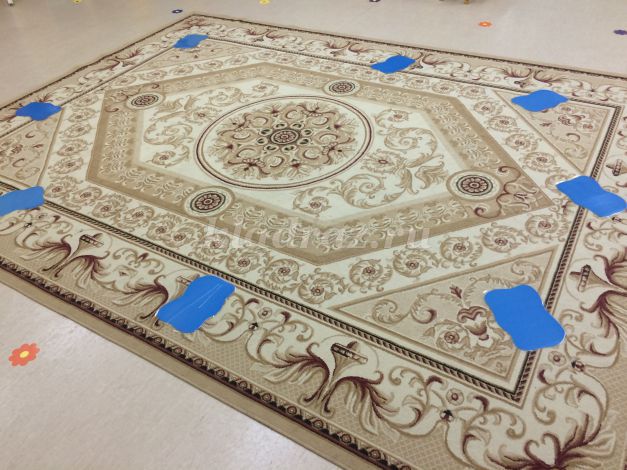
GAME "BEAR WITH A PINE"
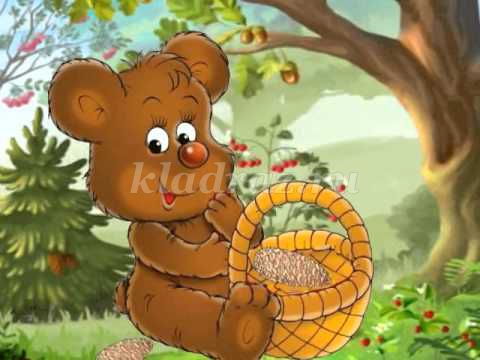
We need to quickly stand in a circle. We will play now. Children stand in a circle.
And they extend one hand forward, palm up. The presenter places the bear in the middle of the circle. I walk around in a circle with a pine cone, -
the leader puts a pine cone in turn on each child’s palm.
I’ll put this pine cone on the children’s palm.
1,2,3,4,5 – Go out and dance with the bear. At the end of the text, whoever has a bump on his palm goes to the middle of the circle, takes a toy bear and dances in the form of a bear (rolling from foot to foot)
GAME “LEAFS”
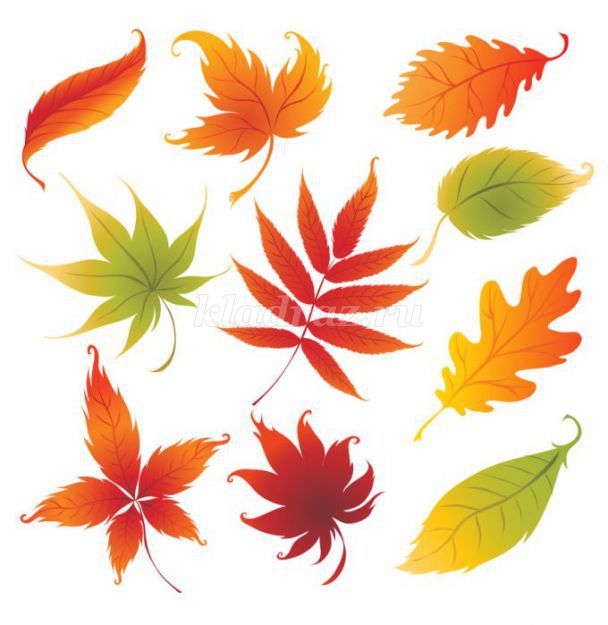
Autumn gilded them and laid them on the ground. We will play with them, we will collect leaves. On command - 1,2,3 Quickly take the leaves. Together we took the leaves and ran along the paths. - the children run with a leaf in their hands.
The breeze stopped, the leaf fell to the ground.
- the children put the leaves on the ground,
raise their legs higher - So we walk through the forest.
- the children are walking in all directions.
The game is repeated.
On command - 1,2,3 Quickly take the leaves. As a complication, you can collect leaves that are only yellow, or only orange, or only red.
On command 1,2,3,
quickly take (red, orange)
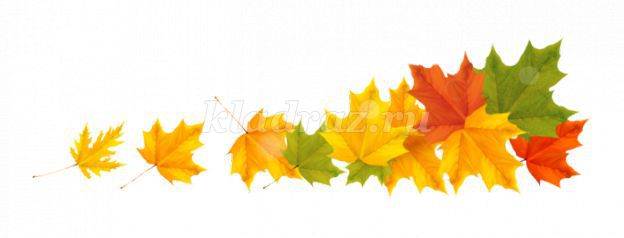
Goodbye!
Related posts:
Autumn exhibition in the senior group in kindergarten Cyclogram of the music director Preparing for Maslenitsa in kindergarten Annual work plan for the pre-school for the 2014-2015 academic year in accordance with the Federal State Educational Standard
Similar articles:
Outdoor games for a walk in the younger group in the fall

